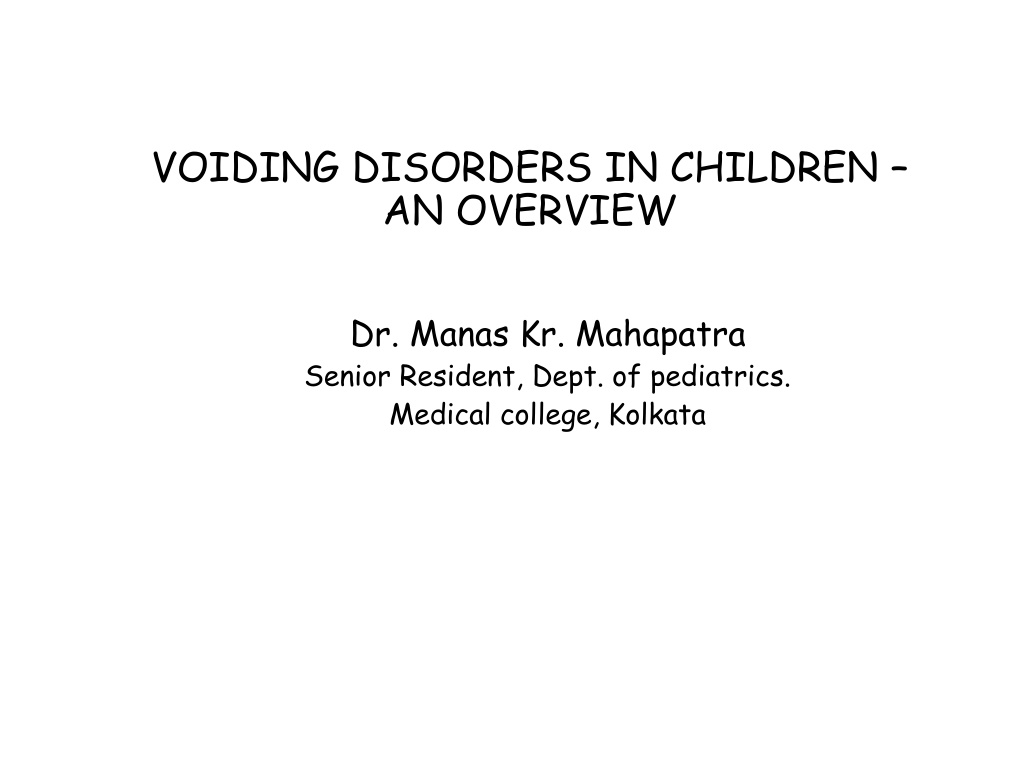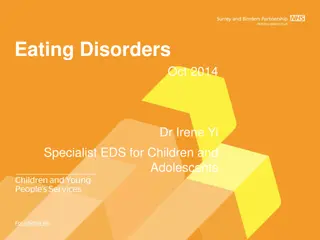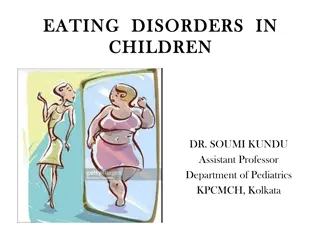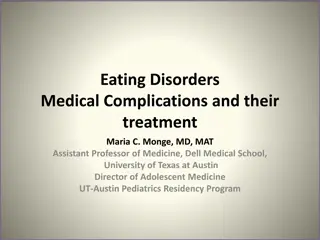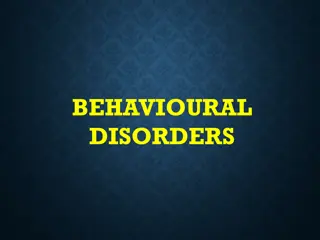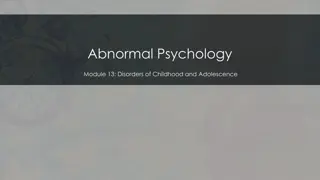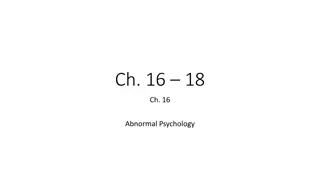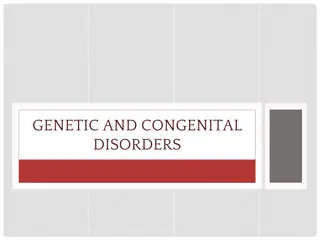Understanding Voiding Disorders in Children: An Overview by Dr. Manas Kr. Mahapatra
Voiding disorders in children, also known as bladder dysfunction, are a common issue affecting up to 40% of pediatric urology clinic visits. These disorders can indicate underlying pathophysiology requiring treatment to prevent renal or urologic damage. The development of urinary control by age 5 is crucial, with most children achieving dryness by then. Bladder dysfunction can result from various causes such as neurogenic abnormalities, anatomic defects, or functional issues without a known cause. Recognizing symptoms like altered daytime frequency and incontinence is essential for diagnosis and management.
Download Presentation

Please find below an Image/Link to download the presentation.
The content on the website is provided AS IS for your information and personal use only. It may not be sold, licensed, or shared on other websites without obtaining consent from the author. Download presentation by click this link. If you encounter any issues during the download, it is possible that the publisher has removed the file from their server.
E N D
Presentation Transcript
VOIDING DISORDERS IN CHILDREN AN OVERVIEW Dr. Manas Kr. Mahapatra Senior Resident, Dept. of pediatrics. Medical college, Kolkata
Introduction Voiding dysfunction now known as bladder dysfunction is a common problem in children having abnormal micturition. It constitutes up to 40 percent of pediatric urology clinic visits. It can be a sign of underlying pathophysiology that needs treatment to prevent Renal/Urologic damage. It can also happen in an anatomically normal lower urinary tract. It hampers child s psychological well-being, self esteem, normal childhood activities and socialization as well as creates great concern to the parents.
Development of urinary control By 5 years 80% children become dry; in remaining 20%, 15% spontaneously become dry each year.
Inervation of bladder CNS micturition centers: Medial frontal lobe, motor cortex (anterior cingulate gyrus) basal ganglia Pontine micturition centre.
BLADDER DYSFUNCTION It describes constellation of symptoms due to abnormal micturition as a result of an abnormal bladder filling and/or emptying. Cause Neurogenic abnormality disruption of the innervation of the bladder or external sphincter due to congenital anomalies (myelomeningocele, spina bifida); trauma to the central nervous system (eg, spinal cord injury), transverse myelitis. Anatomic defects of LUT such as defect that bypasses the bladder outlet eg. ectopic ureter with insertion distal to the bladder neck; obstruction of the bladder outlet (eg, posterior urethral valves); vesicoureteral reflux (VUR) Functional aka idiopathic bladder dysfunction with no known anatomic or neurologic cause. The dysfunction is due neuronal maturation delay, prolongation of infantile bladder behavior, or abnormal acquired toilet training habits.
Bladder dysfunction symptom The ICCS standardized the definitions for bladder dysfunction symptoms for children who are five or more years of age, unless specifically noted otherwise. Symptoms: 1. Altered day time frequency- Increased day time frequency: >/= 8 voiding Decrease day time frequency: </= 3 voiding 2. Incontinence: uncontrollable leakage of urine. Continuous a/w congenital malformations (ectopic ureter) or iatrogenic damage to external sphincter or neurological. Intermittent discrete leakage during day and /or night. Day time incontinence when awake. Enuresis incontinence while sleeping.
Bladder dysfunction symptom 3. Urgency sudden and unexpected experience of an immediate need to void. It may follow incontinence. 4. Hesitancy - difficulty in the initiation of voiding or if a child must wait a considerable amount of time before voiding starts. Applied to children achieved bladder control regardless of age. 5. Straining The application of abdominal pressure (Valsalva maneuver) by the child to initiate and maintain voiding and may be a pertinent finding in all age groups. 6. Weak stream The observed ejection of urine with a weak force and may be a pertinent finding in all age groups. 7. Intermittent stream Stream of urine that occurs in several discrete bursts rather than the normal continuous stream. (this is normal physiologic pattern in children < 3years).
Bladder dysfunction symptom 8. Dysuria Burning or discomfort during voiding. 9. Nocturia: awakening to void at night (without leakage) 10.Holding maneuvers behavior used to either postpone voiding or suppress urgency, such as standing on tiptoe, forcefully crossing the legs (Vincent's curtsy), or squatting with a hand pressed into the perineum. Observed in children achieved bladder control regardless of age. It may leads to incontinence, aka Voiding postponement. 11. Post micturition dribbling involuntary leakage of urine immediately after completion of voiding in children who have achieved bladder control regardless of age. ( commonly a/w vaginal reflux or syringocoele)
Bladder dysfunction symptom Other symptoms: Nocturnal polyuria: overproduction of urine at night ( > 130% of expected bladder capacity for age) Bladder bowel dysfunction (BBD): The classical association of constipation with bladder malfunction. Feeling of incomplete emptying after voiding. Sensation urinary retention: sensation of an inability to void even if the bladder is full (duration of time characterizes retention). Spraying: urine passes as a spray ( ? mechanical obstruction) Genital and Low Urinary Tract Pain: Bladder pain: Suprapubic pain or discomfort related to the bladder. Urethral pain Genital pain: In girls: vaginal pain or itching (due to local irritation from incontinence); in boys: penile pain or episodic priapism (associated with a full bladder, constipation, or phimosis)
ICCS classification of voiding dysfunction Two major categories base on presence of symptom complex in relation to sleep or awake state. 1. Enuresis or nighttime incontinence MNE accounts for 80 percent of children with enuresis. MNE is not a true voiding disorder. 2. Daytime urinary incontinence disorders. Prevalence ( once /2 weeks) ~ 7- 8%.
Daytime urinary incontinence: phenotypes Subgroups : (based on underlying bladder function abnormality) Overactive bladder disorder Voiding postponement and underactive bladder disorder Dysfunctional voiding disorder Other conditions: giggle incontinence, vaginal voiding, and primary bladder neck dysfunction. There may be overlap between these conditions. Changes in symptoms can evolve over time so that a single child may have components of different conditions.
Features of overactive bladder Aka detrusor overactivity. Involuntary detrusor contractions during the filling phase with increased bladder pressure. (normal sphincter activity during filling and voiding phase and normal detrusor contractions during voiding.) Increased voiding frequency, urgency with small and frequent voiding +/- urge incontinence. Holding maneuvers Symptoms aggravated at evening d/t fatigue pelvic floor muscles. Voiding pattern is normal with appropriate relaxation of pelvic floor muscles. A/w constipation. Can present with primary mono-symptomatic nocturnal enuresis or nocturnal enuresis with daytime symptoms.
Features of underactive bladder Inadequate detrusor contraction large capacity bladder and incomplete emptying of the bladder. (Have a normal sphincter function in both phase). Infrequent voiding, emptying is incomplete and occurs in several small but continuous fractions, sometimes overflow incontinence. Abdominal muscles are used to increase pressure on the bladder (valsalva voiding). H/o voiding postponement, dysfunctional voiding.Under active detrusor muscle developed as a consequence of long term high bladder pressure with detrusor de-compensation. Usually a/w recurrent UTIs & VUR Associated features: Symptoms related to psychochological / behavioral abnormality. Lower limb neurological symptoms, anatomical defect of spine, sacrum, perineum. H/o PUV fulguration.
Features of dysfunctional voiding There is abnormal contraction of the urethral sphincter during voiding i.e detrusor and sphincter contracts together.Aka detrusor sphincter dyssynergia. (Have normal detrusor function in both phase and normal sphincter contraction in filling phase.) Some children with dysfunctional voiding that also have an overactive bladder. H/o straining during voiding, lower abdominal pain. Staccato voiding i.e interruption in the urine flow due to bursts of pelvic floor muscle activity during voiding. Voiding is prolonged, interrupted and incomplete. H/o recurrent UTI due to chronic urinary retention, VUR A/w constipation.
Other voiding disorder PRIMARY NECK BLADDER DYSFUNCTION: Due to delayed or incomplete opening of the bladder neck during voiding. Children have normally functioning sphincter and pelvic floor muscles. Symptoms include hesitancy, frequency, urgency, weak urinary stream, pelvic pain or discomfort during voiding, sense of incomplete emptying, and occasional nocturnal enuresis. It can represent up to 15 % of children with persistent voiding symptoms despite conventional treatment.
Other voiding disorder GIGGLE INCONTINENCE Involuntary voiding during sudden laughter. Due to inappropriate detrusor contraction and sudden relaxation of urinary sphincter. Seen in school girls and adolescents. VOIDING POSTPONEMENT Postpones imminent micturition until overwhelmed by urgency. Uses holding maneuvers may have wetting undergarment following this. Symptoms may aggravated at evening due to weak pelvic floor muscle and more water intake at day time. Associated with low frequency. Over-activity of urethral sphincter is a behavioral maladjustment. It is associated with other behavioral problems in these children.
Other voiding disorder VAGINAL VOIDING Seen in obese girls using western toilet. May not apart their thighs adequately. This result in incontinence on standing due to vaginal pooling or reflux of urine into the vaginal vault during urination. This can also lead to vaginitis Most common cause Labial adhesion, Volume of urine 5-10 ml. POLLAKIURIA Child voids extremely frequently at 30-60 min interval. No dysuria (UTI), pain or incontinence. No polyuria. No organic causes found. Nocturia is unusual. Usually stress related. Age group 3-4 yrs. Seen in a previously toilet-trained child.
ASSOCIATED COMORBID CONDITIONS Urinary tract infection Vesicoureteral reflux Constipation: (bladder bowel dysfunction aka dysfunctional elimination syndrome) - 30 to 88 % of cases with bladder dysfunction Behavioral issues. Improper toilet training, limiting bathroom access, discouraging or limiting voiding in response to the urge, avoiding bathroom due to the lack of privacy or sanitation specially in school all can leads to voiding postponement. Parent and child conflict, school problems can leads to voluntary holding. Children withADHD, anxiety. Neuro-devlopmental issues. Developmental delay leads to delay in gaining voluntary bladder control.
Voiding disorder: When to suspect. Daytime urinary incontinence in previously toilet-trained children. Persistent abnormal urinary symptoms such as urgency, dribbling, or pain during urination. Recurrent UTI especially girls with cystitis, persistent VUR, prior surgery of PUV with persistent VUR, Chronic constipation or encopresis. Enuresis with daytime symptoms. Failure of toilet training (suggest occult anatomical abnormality). H/O pathology related to structural abnormality of bladder & urethra, abdominal pressure, kidney function, central or peripheral nervous system. Suspected neurologic abnormality especially involving spine and lower limb should be evaluated for occult neurologic lesion.
Evaluation and diagnosis of bladder dysfunction in children
Goals of evaluation To identify which phase of bladder function in affected (filling and /or emptying). To find out the underlying cause (organic cause (ie, neurogenic or anatomical or iatrogenic) or functional causes) To rule out differential diag. Causes of secondary bladder dysfunction- eg. constipation, urinary infection, cristalluria, behavioural disorders (ADHD), psychological stressors in family & school. Causes of urinary leakage without bladder malfunction: Vaginal voiding, pollakuria. Genito-urinary infestations by Enterobius vermicularis. Polyuric conditions eg. Diabetes mellitus, diabetes insipidus, diuretics, psychogenic polydipsia increasing an underlying incontinence, Sexual abuse it can have secondary urinary incontinence as only clinical manifestations.
Tools of evaluation Initial Evaluation Thorough history including diary. Focused physical examination Non-invasive testing such as a urinalysis and urine culture and Sometimes USG KUB (should not be a part of initial inv. can be done if indicated) Further Evaluation (As needed): Urologic imaging studies, measurements of urinary flow, and post-void residual determination. (in selected children) Formal urodynamic studies to diagnose the underlying problem to determine the most appropriate therapeutic approach (in more select group of children)
The history Voiding schedule frequency of voids; the frequency of incontinent episodes, an estimation of the voided volume. Symptoms of bladder dysfunction Bowel habits for constipation. Validated survey tools include: The Dysfunctional Voiding Symptom Survey (DVSS): Incontinence Symptom Index-Pediatric: Dysfunctional Voiding and Incontinence Symptoms Score:
The history Voiding diary (Frequency volume chart) 48 hrs voiding diary helpful. Small bladder: If maximum voided volume < 65% of expected bladder capacity Large bladder: If > 150%. Polyuria: >2 lit/m2 BSA / 24hrs. Expected bladder capacity: > 2 years: (1+ age in yrs x 30) ml. < 2 yrs: wt in kg X 7 ml.
The history Family history any kidney or urologic disorders including bladder dysfunction, age that other family members achieved urinary continence ( for familial maturational delay in achieving bladder control). Perinatal and neonatal history perinatal anoxia or congenital infection, that could alter the central and peripheral nervous system normal coordination of bladder function. Fluid intake The amount and type of fluid; excessive fluid intake and/or fluid intake during the night time (may be suggestive of polyuria) Toilet training history whether toilet training was prolonged, delayed, or stressful, and whether there was a period of dryness after toilet training.
The history Neurodevelopment delay: developmental delay may leads delay in gaining voluntary bladder control. H/O UTI with and without vesicoureteral reflux (VUR). Psychological disorders an increased risk of bladder dysfunction in children with depression, anxiety, and ADHD. For objective assessment ped urinary incontinence quality of life score (PIN-Q) Family/parent/caregiver conflict or stress Behavioral issues arising from toilet training, personal stress, conflict between the parent/caregiver and child leads to voluntary holding with postponement of voiding.
Physical Examination General exam: short stature, HTN, anemia. Lower back & Spine: For signs of occult spinal dysraphism or sacral agenesis, such as a pre-sacral dimple, hair patch, lipoma, or asymmetric gluteal cleft. Scoliosis / kyphosis, gibbus, gait. Focused neurologic examination: Lower limb strength and deep tendon reflexes, gait, fine-motor coordination, gluteal cleft deviation. Perineal and anal sensation, anal wink (anocutaneous reflex), and rectal tone. Abdominal and rectal examination Tenderness due to colonic distension by impacted stools, palpable impacted colonic stools. Digital rectal examination for any distended rectum that is full of stool. Palpable bladder / kidney. Abdominal muscle tone.
Physical Examination External urological and perianal examination: In boys: Look for meatal stenosis, and position. In girls: For any evidence of labial adhesions, vaginal pooling . Areas of skin excoriation or redness (sign of continuous or severe urinary leakage). Perianal inspection: for the position of the anus, and the presence of dermatitis, and perianal feces, fissures. Observation of the urine stream: direct observation of voiding and urinary stream for any evidence of hesitancy, dribbling, intermittency of voiding, or weak stream. Evidence of sexual or physical abuse.
Initial investigations Urine R/E: Glycosuria, hyposthenuria, low specific gravity. Pyuria (WBC> 10 / hpf) Crystals Urine C/S: if UTI suspected. Ultrasonography KUB most commonly used imaging modality, non-invasive study. Indication: Suspected urinary tract infections, Symptoms suggestive of an obstructive process (eg, weak urinary stream, palpable bladder mass). Suspected neurologic or anatomical lesion.
Initial investigation USG KUB helps detect : Structural abnormalities, such as hydronephrosis, ureteric duplication with an ectopic ureter; kidney size, scarring, stone; posterior urethral dilatation. PVR urine: > 20 mL on repeat measurement or > 5ml is in a child within 5 min of voiding is significant. incomplete bladder emptying (BOO) seen in underactive bladder and dysfunctional voiding. Bladder wall thickness: Normal < 3 mm when full or less than 5 mm thick when relatively empty. A thickened bladder wall of outlet obstruction. Bladder size small in detrusor over-activity. Large BOO, Underactive bladder. Wall irregularity Evidence of cystitis, recurrent UTI. Rectal diameter >30 mm indicates rectal stool impaction.
Diagnosis: Types of dysfunctional bladder. Based on hallmark clinical symptoms, bladder dysfunction is grouped according to the types of bladder as follows: 1. Overactive bladder The hallmark symptom is urgency. 2. Underactive bladder long h/o voiding postponement, straining to aid in voiding, and have a weak and interrupted urinary stream. 3. Non-neurogenic dysfunctional voiding straining to void with dribbling, lower abdominal pain, staccato voiding. H/O constipation (bowel-bladder dysfunction). 4. Voiding postponement low voiding frequency with large volume, typical utilization of holding maneuvers to suppress voiding.
Management approach Treatment of secondary causes: Constipation, UTI, VUR, Behavioural (ADHD, anxiety), Neurodevelopmental issues Psychosocial stress relief Voiding behavior modification. Conservative measures: Pharmacotherapy Pelvic floor relaxation techniques, biofeedback, Neuromodulation Intermittent clean catheterization Targeted therapy to treat underlying cause Botulinum toxoid injection. Mitrofan off technique Augmentation cystoplasty Surgical
Conservative management Retrospective studies: reduction in symptoms in approximately 40 to 70 % of patients treated conservatively Voiding behavior modification Goal: to rehabilitate the bladder and sphincter function and return the child to reclaim normal voiding habits. Components: Patient education: Providing information about normal voiding habits, urgency control strategy,pelvic floor relaxation (deep breathing exercise in relaxed position) to mother and child with repeated reinforcement. Reviewing the child's voiding habits & posture to identify deviated habits & to correct Setting an individualized timed voiding regimen - a timed voiding schedule with gradually increasing voiding frequency to voiding every 2-3 hourly during the day and to take adequate time to void.
Conservative management Voiding behavior modification Establishment of a fixed timed schedule for a child with ADHD. Working with the school system to create an environment to allow frequent voiding. Avoid holding maneuvers. Encouraging to urinate before a sense of urgency, to empty bladders completely and to avoid abdominal straining. Document the voiding process in a diary after implementation of voiding behavior modification. Establish a reward system (positive reinforcement) for following the treatment regimen not for being dry, as being dry is out of his/her control. Self motivation.
Conservative management Bladdr Bowel Dysfunction: Constipation: Dietary modification: Increased fluid intake, high fiber diet. Dis-impaction and maintenance therapy of laxative (polyethylene glycol). Resolution of constipation was reported to be a/w elimination of wetting in 89 and 63 %of children with daytime or nighttime urinary incontinence, respectively. Other measures: Elimination of diets that increase bladder activity eg. caffeine, orange juice, tomato products, and spicy foods. Avoid bubble baths or cleaning the perineal areas with soap, can result in or worsen urethritis or in girls, vaginitis. Good perineal hygiene to avoid perineal and genital irritation, discomfort , risk of urethritis, vaginitis from bad hygienic conditions. Girls having vaginal voiding: to sit for an extra 1-2 minutes after emptying their bladder to allow the drainage of urine that has refluxed into the vaginal vault.
Directed therapy to treat the cause If conservative treatment fails, directed therapy targeting specific cause of bladder dysfunction to be given. Overactive bladder: Trial of an anticholinergic agent. Alternative: neuromodulation, expensive and not universally available. Underactive bladder and elevated post-void residuals: Timed voiding and double-voiding. If fails to respond to voiding modification a trial of CIC to timed voiding schedule for effective bladder emptying.
Directed therapy to treat the cause Non-neurogenic dysfunctional voiding or primary neck bladder dysfunction: Biofeedback therapy to reduce symptoms. Alpha adrenergic receptor antagonists (limited data, their routine use cannot be recommended).
Anticholinergic drugs To be added if initial 4-8 weeks trial of conservative measures fails. Drug of choice: Oxybutynin, thrice daily dose. Extended-release form of oxybutynin, once daily dose. US FDA approved for the treatment of OAB in children. Starting dose: 2.5 - 5 mg tab, max 15-20 mg/ day ; orally for 4 wks.; for 5 yrs age group. Response within first wk Susp. oxybutynin elixir: 0.1 to 0.2 mg/kg per dose given 2-3 times a day. If good response and free of overactive bladder symptoms, continue for 4 months stop medication. If symptoms re-curs restart. Contraindications underactive bladder, interrupted (fractionated) voiding pattern, history of urinary retention, or high post-void residual volumes; gastric retention, decreased gastric motility, or significant bladder outlet obstruction.
Anticholinergic drugs Side effects d/t blockage of M1 receptor subtypes. Common adverse effects: new-onset constipation, dry mouth, flushing, heat intolerance, nausea. CNS S/E: blurring of vision, hallucination, headache, agitation, sedation, confusion, amnesia, and nightmares.. Other anticholinergic drugs : If intolerable adverse effects of oxybutynin. These are selective M3 receptor antagonist. Solifenacin (approved by the FDA in 2020 for the treatment of neurogenic detrusor overactivity in two years). Tolterodine, darifenacin and trospium not approved in children. Tolterodine- 1 mg twice/ day for older child.
Other drugs Beta3-adrenoceptor agonists relaxation of the detrusor smooth muscle during the urine storage phase, thus increasing bladder capacity. Mirabegron, as monotherapy or in combination with other agents may be beneficial with improvement of symptoms in OAB. Not recommended for routine use. Alpha adrenergic receptor antagonists relax the smooth muscle at the bladder neck and proximal urethra. Particularly beneficial in non-neurogenic dysfunctional voiding and in those with primary bladder neck dysfunction. Doxazocine 0.5 mg 1 mg /day. Tamsulosin 0.4 mg/day Not recommended for routine use. limited data in children.
Biofeedback and pelvic floor muscle training It helps children to identify and control the muscle groups involved in voiding by voluntarily relaxing or contracting sphincter and pelvic musculature and observing the response in real-time visual displays of urinary flow and electromyography (EMG) activity. Indications: Persistent bladder and sphincter dyssynergia despite an adequate trial of conservative therapy and/or pharmacotherapy. Significant post-void residuals who have recurrent urinary tract infections and constipation. Pelvic muscle (Kegel) exercises strengthen the pelvic floor musculature which reflexly inhibit detrusor. Pelvic floor relaxation techniques helps the child learn to relax the pelvic muscle groups involved with voiding. .
Electrical stimulation therapy (neuromodulation) Modulation of pelvic muscle contractions and/or detrusor activity by implantation of noninvasive electrodes to stimulate nerves. Placing electrodes in anus or vagina or Sacral nerve stimulation (SNS) via implanted or transcutaneous electrode, or Transcutaneous stimulation of the posterior tibial nerve (PTNS). Indications Select group of children who have refractory overactive bladder to behavioral and anticholinergic therapy. SNS for 20 minutes twice daily as this is a regimen that appears to be safe and well tolerated in children. Stimulating spinal inhibitory pathways reduce detrusor (bladder muscle) contraction OAB.
Botulinum toxin A ( not FDA approved ) Cystoscopy guided direct injection into the detrusor muscle (except trigone) or external urinary sphincter to block neurotransmitter release from the peripheral afferent nerve terminals and inhibit efferent muscular contraction. Primarily used in children with neurogenic detrusor-sphincter dyssynergy or overactivity. Limited data on its effects in children with non-neurogenic dysfunctional voiding. Intravasicle inj. Botulinum toxin Dose 10-20 U/kg. max 300 u, Effective for 3-12 month, repeat.
Clean intermittent catheterization (CIC) Effective and safe intervention for bladder emptying. Allows patients to attain continence and reduces the rate of recurrent UTIs. CIC should be done in association with an established timed voiding schedule. Indications: In underactive bladder (myogenic failure), incomplete emptying resulting in large post-void residual volumes. Severe dysfunctional voiding with large PVR (HINMAN BLADDER)
Surgery Indication: Neurogenic bladder and very rarely for refractory non- neurogenic bladder dysfunction with markedly elevated bladder pressure and failure of medical management. Aim: To augment the bladder for safe storage of urine and/or to achieve continence, thus to prevent kidney damage as in in detrusor overactivity and small capacity bladder. To make alternate route for CIC Mitrofan off technique: appendix used as conduit for dysfunctional voiding. Bladder augmentation is usually achieved by adding an isolated segment of bowel to the bladder. Cystoscopy with urethral dilation is no longer routinely used to treat bladder dysfunction (little data to support).
The long-term outcome: Typically excellent with resolution of their symptom. This resolution of symptoms is most likely due to the natural history of bladder dysfunction rather than to medical interventions. One study suggested that girls with childhood incontinence are more likely to have urge symptoms and incontinence in adulthood. In 2003, one study from US (199 Patient) noticed that 91% of the patients no longer were incontinent and 82 % no longer had urinary tract infections in 6.5 years follow up.
